
Hiring and retaining competent and talented employees has been a top priority for any human resource department (HR) in an organisation. Hiring and retaining employees are two sides of the same coin; though you may be able to hire competent and talented employees, retaining them is a different matter to tackle.
To encourage employees to remain in an organisation, HR utilises one of its professional arsenals; an attractive compensation package that employees will find hard to refuse. According to research published by PWC Global, Hopes and Fears 2022, 71% of employees opinionated that the most important factor in a workplace is compensation and workplace benefits.
However, before you determine what compensation packages to offer, it is important to understand the definition and objectives of compensation.
The technical definition of employee compensation refers to the monetary payment provided in exchange for services provided by employees or hired hands. This includes salary in addition to any other incentives or perks that come along with the job or position.
When planning for employees’ compensation, you must first understand and decide the objectives for your employees' compensation — the purpose of it. This is so that your compensation is aligned with your intention and employees’ best interests.
In addition, there are four questions that you should consider and ask yourself when designing a fair compensation strategy:
The first question you need to ask yourself is, what counts as compensation in your company? This is because compensation is more than just providing monetary payment to your employees — it can be the ability to remote work, a hybrid work schedule, medical treatment coverage, or any other non-monetary benefits.
This combination of rewards and benefits is called employee total compensation (TC), offering both monetary and non-monetary rewards and benefits to employees in a company. The employee total reward is provided in addition to gross pay, it can include traditional benefits (medical and healthcare), voluntary benefits, retirement plans, vacation time, pensions, stock options or even equity.
To find out which rewards resonate well with your employees, conduct a company-wide survey to find out what are your employees' preferences for the employee total reward packages. As for the survey timing, it can be conducted six months before the enrollment period — this will provide you with ample time to evaluate and organise new offerings.
Most companies’ HR view such offerings as a part of the compensation package because they are informed of the associated cost. The hiring cost of a new employee goes beyond their salary; benefits and other compensation such as equity should be considered.
So when employees do not know about the costs like these, they will feel less inclined to view their compensation as competitive. This is when your company’s HR should share the employee's total reward statement. The total reward statement is an itemised one-pagers that will highlight all the benefits you are compensating your employees — in dollars, euros or pounds. The companies that provide employees’ total reward statements do so at least once a year.
They will typically list out the combined compensation made of monetary and non-monetary rewards given to the employees. For example:
• Salary
• Bonuses
• Commission
• Retirement benefits
• Stock options
• Paid time off
• Profit-sharing
• Employer-paid premiums for health, vision, and dental insurance
• Stipends
• Disability and life insurance
• Employer-paid Social Security and Medicare taxes
Salary or pay band refers to the minimum and maximum amounts a company is willing to compensate employees based on their job levels. For example, if job levels help you to set up a career path hierarchy for employees, salary banding serves a similar purpose as compensation.
For example, a Level 1 Designer at your company will be eligible to earn $50,000 to $70,000. While a Level 4 Designer, like an Associate Design Director, will be eligible to earn $100,000 to $130,000. These salary bands help define and communicate with employees and will allow them to understand their earning potential and how much their future promotion can provide.
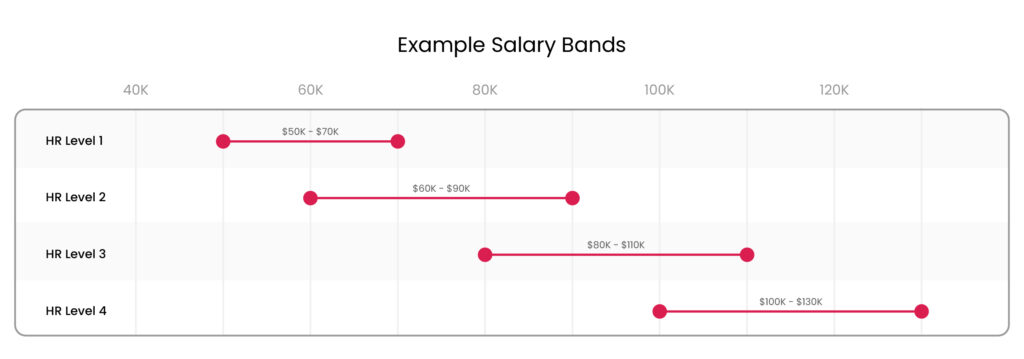
A salary band like this serves an important purpose in your company’s compensation strategy. From a financial point of view, salary bands are vital for budgeting. This is because, without salary bands, your company will not be able to forecast overhead costs, plan a growth strategy or plan rewards for performing employees without risking your company’s financial health.
However, salary bands also serve an additional purpose. Salary bands are also used to facilitate your employees’ career development and pay conversations based on competencies and job levels.
In addition, and just as important, providing minimum-maximum salary ranges can help clear the ambiguity surrounding employees’ pay and help the HR team to identify and prevent pay disparities.
There should be several factors that influence your company’s salary bands, such as role expectations, education, experience and geography — all of which need to be backed by market research. There are also broader economic factors that should be influencing your company’s salary bands; inflation or cost of living — both impact a job’s market rates.
Besides the market rates and geography, you will want to take a look at each role’s skills and influence. Though it is typically assumed leadership roles warrant a higher salary than those in contributor positions, it is not always the case. For example, having a competent junior employee with high-in-demand skills that tangibly affect your business — warrants a salary that outearns managers in other departments.
Also, it is advisable to have a degree of flexibility in your salary band structure. For example, a Level 2 employee deserves recognition and promotion but is not quite ready yet. Their manager can instead reward an increase on par or similar to the next level starting salary because the salary band overlaps.
For the compensation model with merit cycles, where employees receive pay raises based on past performance. Such a compensation model is common, especially for sales roles. But it also can be divisive because some of the leading HR professionals believe that such a compensation model might hinder conversations related to growth and performance.
However, despite such beliefs, performance-based compensation models are growing increasingly popular among companies. In addition, according to a study's key finding, linking pay to performance or performance-based compensation increases employees' productivity and raises job satisfaction level.
Compensation is a very powerful motivator for employees, there’s no denying that. An attractive compensation will likely convince employees to continue providing their skills and talents to the company they’re working for. However, must bear in mind that compensation is not a sure and definite method to retain competent and talented employees.
As mentioned above, respectful treatment at the workplace is what most employees consider the most important. So, even if your company does an attractive compensation package but you’re not treating the employees with respect, employees will leave.
A study has shown that strongly linking attractive compensation with performance lead to greater employee satisfaction, trust in leadership and better motivation. The same study also showed a weak relationship between compensation (reward) and performance can be detrimental to employees' motivation.
Strongly linking compensation and performance will provide a tangible way for employees to see the benefits or improvements they bring to your company.
Performance-based compensation may be gaining popularity, but a majority of employers do not disclose it works to their employees. This lack of transparency will cause employees to feel frustrated. Hence, employers should provide a clear rationale to employees why they’re doing so.
In practice, a member of the HR team will need to announce and outline your company’s approach to merit increases during a company-wide meeting. Due to the personal nature of compensation, invite employees to anonymous questions before the company-wide meeting session and do a follow-up via email with clarifying points.
Planning to be clear about pay-for-performance also means equipping managers with talking points they need to field questions from direct reports during performance discussions.
There some critics claim that the pay-for-performance compensation model can distract employees from having meaningful performance conversations. Employers may counter this by limiting merit increases to specific quarters so they won’t overlap with performance reviews. In addition, separating the two will help provide time for employees and managers to process and evaluate how they have performed against the job competencies that your company has outlined.
Your company managers will require those contexts when deciding whether to approve a higher or lower increase.
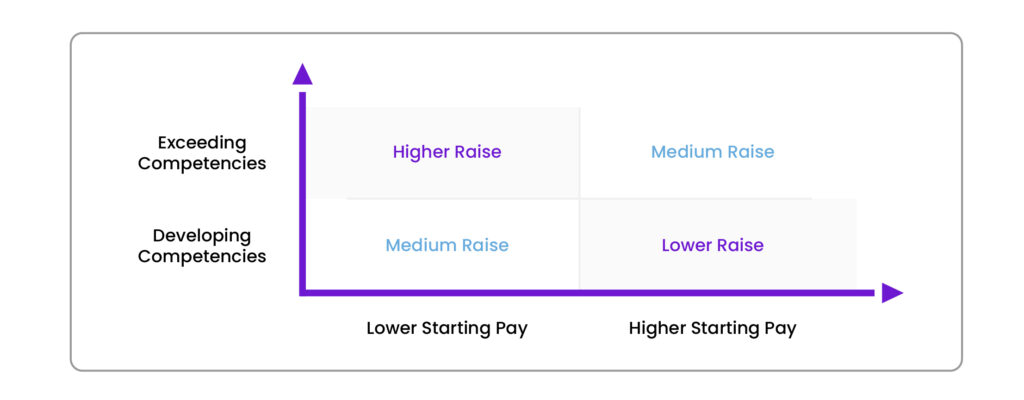
One of the common complaints employees would make about compensation packages is that their employer doesn’t fully disclose it to them. However, the complaints are not necessarily about numbers, but more about how they do not understand how the pay increase gets determined. This makes disclosing and helping employees understand the calculus behind pay decisions a prerequisite to building trust in the process and believing that it is equitable. Simply put, “lack of transparency” is one of the main complaints often voiced by employees.
However, this is not limited just to individual contributor employees, but also the HR team. Their opinion is that most managers are not equipped for pay transparency conversations with their employees.
This is where pay transparency comes into play. Pay transparency is an approach companies take when communicating and conveying their compensation philosophies to employees. As we have mentioned before, employees do not necessarily want to know how much pay their peer earn, but this might be a favoured and good approach in some companies.
To help you understand pay transparency; pay transparency fall on a spectrum ranging from a very open model to a very closed one.
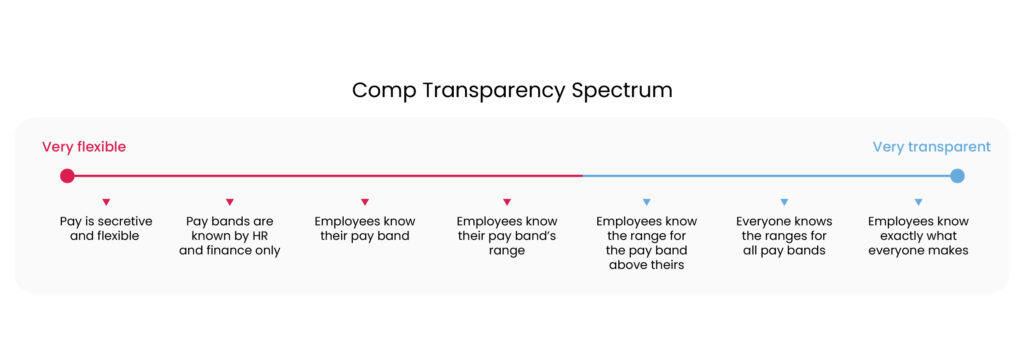
The current trend for the level of transparency is leaning towards more, not less transparency. Because even with a modest level of transparency; if it is still able to help employees understand how salary bands work and what factors influence when determining pay, they will be more inclined to trust the process.
Though a full or modest level of transparency might not work and be suitable for some companies, especially companies without a fully developed compensation strategy and system. This is because full transparency or even modest transparency made in front of the company will expose discrepancies in pay and compensation. The discrepancies however commonly originated from legitimate sources and reasons such as years of tenure, geography, or educational background.
The most important component in pay transparency conversations is communication. An HR team should reiterate their company’s compensation philosophies, including their approach to transparency, to employees — company-wide, during an advance performance review or upcoming compensation cycles.
A more practical level of transparency; might involve employees knowing and understanding their current pay band’s range and the one directly above them. This model of transparency will allow employees to understand their role’s potential earnings, and provide them with a realistic set of expectations during compensation conversations. This would be valuable information for the report’s manager to have since they will be coaching the employees.
In People strategy, the word “trust the process” carries additional meaning. Performance management is the best example here. A survey showed some companies exhibit gender, racial and religious bias; about 50% of female employees experience gender discrimination and 22% of female employees experience racial or religious discrimination at their workplace — hence cutting them off from proper compensation such as adequate maternity leave.
This happened because of the lack of formal review processes in some companies. Without the proper system, managers will fall back and rely on their “gut feeling” when making decisions for roles and compensations for their employees. Having proper compensation, performance and merit increase policies will provide your company with a headstart in the fight to pay for equity.
Additionally, salary bands will reinforce your commitment to pay equity in more obvious ways. HR and finance teams won’t be able to have a stopgap in place — to protect against out-of-control disparities, without minimum and maximum salary ranges assigned to each role. For example, a situation where there are two employees with the same role, but one of them earns more than the other without clear factors and reasonings. Such a gap could be from deliberate or unconscious bias, however, it could also result from less nefarious reasons — an inexperienced manager recommending more generous merit to increase their team. In either case, salary bands will be able to provide clear guidelines to follow, providing managers with a degree of flexibility when determining salary.
However, salary bands do not help in countering biases that can cloud and impair evaluations and future promotions. So if your company is planning to opt for linking performance and compensation, it is advisable to root out inequities during reviews.
One of the most helpful and impactful steps is to incorporate performance adjustments into your review cycles; where managers will come together for a discussion moderated by HR to discuss their reports’ performance rating. Since each manager will have different opinions and interpretations of what constitutes good or bad ratings, these discussions will help managers to go over these differences by requesting managers justify and explain their thought process and finally have everyone on the same page so that everyone will follow the same standard.
Compensation is important in how you attract and retain employees, but compensation is only of several pillars. Other pillars are just as important and where compensation can be integrated into; performance reviews, engagement surveys, check-ins, and development conversations.
However, getting all the mentioned programmes to work together in harmony will require a thoughtful and timely approach and execution. For example, your company arranges and schedules performance reviews and compensation decisions in alternating quarters. This is to avoid self-growth conversations with employees from getting sidetracked. Such an approach also will provide employees and managers with time to prepare and set growth plans and deliver them in time for promotion or merit increase.
Additionally, you can run engagement and pulse surveys year-round to provide you with insights into your total rewards strategy and whether you’re meeting employees' expectations. One crucial point to remember is that although your compensation is structured, it is not fixed and should have flexibility. Your employees' feedback should and can influence your compensation structure over time.
Compensation isn’t just about numbers, it is a critical and integral part of people management. Your employees will want to be properly rewarded for their efforts and services rendered.
But not having a proper structure or tools in place for compensation, it will be easy for your employees to feel demotivated and lose faith. Furthermore, companies without solid and proper compensation philosophies will struggle to come up with answers to key employee questions. Unclear compensation philosophies can breed distrust, suspicion of bias, disengagement and ultimately turnover.
So it is important to take a holistic approach to engagement, performance management and development and properly integrate compensation philosophies into them to create a thriving workplace.

With the wave of digital transformation and progression sweeping across the world, people become more observant and realise their priorities; employees and candidates are now more demanding about pay transparency than a few years ago. It is no longer acceptable for companies to disclose only sparse salary information to employees or candidates because pay transparency has become vital in creating a thriving and high-retention workplace. In fact, according to a survey conducted by PWC Global, Hopes and Fears 2022, 60% of employees say that pay transparency is essential as it affects their overall economic flow.
Hence, companies will need to learn how to navigate salary transparency conversations effectively so that they will be able to attract candidates and retain current employees.
Candidates believe that there should be a law mandating employers to include salary ranges on job listings, which benefits both employers and job seekers. By practising pay transparency, employers will appear more attractive to job-seeking candidates and will be able to stay competitive. In addition to that, pay transparency will be able to help employers to address pay gap issues by discussing in detail with candidates about their pay compensation and how it progresses moving forward if candidates do join the company.
Also, a survey conducted by Gartner revealed that 50% of employees didn’t apply for a role because the job listing didn’t include a salary range. So to increase the chances of attracting candidates to apply for roles, employers should include a salary range in their job listings, to let candidates know the salary range they should expect and the amount they can negotiate during their interview.
One of the benefits of practising pay transparency is pay equity. When employers are more transparent about how they will compensate the applying candidates, they’re more accountable for practising fair pay practices. Besides pay equity, there also several other benefits such as:
According to Resume Builder, 85% of candidates will likely apply for a role in a company when the job listing includes a salary range. This is because candidates want to know if the salary range employers are offering is aligned with the expectations and responsibilities that come with the role they are applying for. This is to avoid disappointment and waste both parties' time and resources.
An attractive compensation package is one of the major reasons for candidates to apply. Being transparent about the compensation package candidates will receive for their role early on during the recruitment process will help to screen out candidates that find the compensation package doesn’t align with their expectations. This will help recruiters to focus on more viable candidates that will increase the company’s efficiency and productivity.
An interview session that is transparent about salary range will increase a candidate's positive interview perception by 30%. This will improve a candidate’s view of a company and keep them engaged in the recruitment process.
According to a survey made by Gartner, employees who perceive their pay as inequitable have a 15% lower intent to stay with their current employer. Providing transparent pay experience to both candidates and current employees will help employers to retain their talent and engage them effectively.
Much like everything else in this world, there are also caveats to pay transparency stance despite the benefits it can provide. A current and recent survey shows that only 12% of companies around the world are willing to take the pay transparency stance. This is because pay transparency is a very narrow path for employers to navigate through and there are a lot of challenges to tackle, such as:
When there is pay visibility provided, there is a risk to invoke jealousy or resentment to spread among a company’s employees. To avoid this, a company-wide announcement and meeting must be conducted to provide an explanation and justification for the pay decisions that were made. This will help employees to understand why the pay decisions were made as such, thus hopefully suppressing workplace envy or resentment from continuing to spread among employees.
When employers include a salary range that is less competitive in their job listings, may experience candidates having less interest. Resulting in fewer applications and less response rate.
Since pay transparency comes with its own set of caveats, employers should consider preparing themselves before adopting a pay transparency stance so they can effectively tackle any issues that surface once they once have adopted pay transparency.
There is no one-size-fits-all approach when it comes to pay transparency. However, the most important thing to consider is a company’s culture and any applicable law to design pay transparency that is suitable for a company’s environment and culture. For example, measure and analyse the situation by handing out incognito surveys to gauge the suitable and comfortable amount of pay transparency level. Then design the pay transparency policy based on survey results.
To effectively apply a pay transparency policy, a company needs to have a well-structured and well-aligned compensation philosophy. For example, a company needs to take into account what counts as compensation, because different companies have different understandings of what counts as compensation; some may schedule flexible and good salary range advancement, etc. And the best way to present a company’s compensation is by using a total reward statement where employees will be able to read and see a list of rewards included in the compensation that they’re entitled to.
To continue effectively attracting new talent, companies will need to update their pay range. However, before a company updates their pay range, a company should run a pay analysis to compare the current updated pay range against its current pay range. This should allow companies to structure their pay update fairly.
Adopting a pay transparency policy means there will be a lot of pay transparency conversations and questions with employees. Companies’ managers and leaders need to be aware of what drives pay transparency demand so that they effectively address the questions during pay transparency conversations with employees and translate the conversation effectively into their reports.
Pay transparency policy has a lot of moving parts and is a complicated practice. So, it will require constant monitoring of matters such as; employees’ sentiment, pay equity, and offer acceptance rate. This way, companies can adjust and fine-tune their pay transparency policy as they progress forward.
The demand for pay transparency is increasing in today's digital age. Companies must recognize the importance of providing comprehensive salary information to both employees and candidates. Pay transparency not only helps create a thriving and high-retention workplace but also attracts top talent and maintains competitiveness. Including salary ranges in job listings is crucial to increase candidate interest and avoid wasting time and resources. Furthermore, pay transparency promotes pay equity and accountability for fair compensation practices. It also enhances the candidate experience, boosts productivity by attracting candidates genuinely interested in the compensation package, and improves retention and engagement among employees.
However, pay transparency does come with its drawbacks. Workplace envy and resentment can arise when salary information is openly shared, necessitating clear communication and justification of pay decisions to avoid negative effects on employee morale. Moreover, companies may face reduced interest from candidates if their salary ranges are less competitive. Companies need to prepare themselves before adopting a pay transparency stance, considering their organisational culture, applicable laws, and the ideal level of transparency. They should establish a well-structured compensation philosophy, update pay ranges effectively, and ensure that managers and leaders are equipped to address pay transparency conversations and questions. Regular monitoring and adjustment of the pay transparency policy are also necessary to address emerging challenges and maintain its effectiveness.
In conclusion, embracing pay transparency can lead to numerous benefits for companies, including attracting top talent, promoting pay equity, boosting productivity, enhancing the candidate experience, and increasing retention and engagement. While there are challenges and drawbacks associated with pay transparency, careful planning, implementation, and continuous monitoring can help organisations navigate this complex landscape successfully. By embracing pay transparency, companies can create a fair and transparent environment that fosters trust, attracts the right candidates, and supports long-term organisational success.

It's no secret that the job market is still largely dominated by males, as evidenced by employee diversity data from the Fortune 500 companies (which make up about 2/3 of the US economy). According to Deloitte, only 27% of Fortune 500 board members are women (including both white and minority women). And only one in six of the Fortune 500 publish annual DE&I reports to commit to progress, and to hold themselves publicly accountable.
While there’s no single reason why this imbalance continues to exist, one factor is clearly present: The language used on job descriptions tends to appeal more to men than women. So what can be done about this problem? Well, one great way would be to stop using gendered language altogether! And even though we're not saying you should never use pronouns like "she" or "he", it’s important to consider how your job description might read differently depending on who you're trying to attract as candidates.
The method above can be classified as being inclusive, a term that’s actually a buzzword which has been around for a while, but its meaning has evolved over time. In the past few years, it's become synonymous with being open-minded and accepting of others, including those who are different from you.
In today's modern workplace, it can be difficult to find ways to incorporate this type of thinking into your hiring process – especially since most job descriptions are so rigidly structured around specific requirements (and even then, those requirements may not always be met). When you're writing a job description, it's important to remember that your goal is to attract candidates with diverse backgrounds and experiences. A well-written job description will help you do this by focusing on the skills and abilities needed for the position, and there are ways to make sure that your job ads are truly inclusive, which we’ve covered the top tips for you below.
As we’ve mentioned above, choosing to use words that can be interpreted as gender-neutral language in your descriptions is a surefire way to ensure that you're creating an inclusive environment. Additionally, you’d be able to reach a broader and more balanced selection of applicants, as proven by studies which found that job ads with gender neutral terms see an increase in the likelihood of hiring more diverse teams, up to 46% when hiring women.
As such, avoid using gender-specific pronouns, like the conventional “he” or she”. Instead, use words like “they”, or make sure all jobs are open to applicants of any gender by using "and/or" when listing qualifications or requirements for the position. You can even word your job ads to sound like they’re speaking directly to the candidate.
Instead of writing “He will design, code, test, and implement our solutions” for the position of a Software Engineer, putting “You will design, code, text, and implement our solutions” ensures that jobseekers don’t get the impression that the role is geared towards males only.
You can also choose to use gender-neutral job titles to entice candidates to click in and read the rest of your job posting. Try substituting words like “fireman”, “foreman”, and “Chairman” with words like “firefighter”, “supervisor/manager”, and “Chairperson”.

It may seem obvious that you should steer clear of any form of bias when creating an inclusive job ad. However, it's easy to fall into this trap unknowingly, since any one of them can be unconsciously implied when creating a list of qualifications based on previous experience working in similar industries.
Take, for example, racial bias that refers to a set of attitudes or beliefs that one race is superior or inferior to another. It can appear in formerly-popular phrases like “blacklist” (defined as a collection of entities that are blocked from communicating with or logging into a computer, site, or network), “brown bag session/lunch” (referring to informal business meetings or training sessions usually held in an office setting during lunchtime), and “cakewalk” (which means a surprisingly easy task). They’re now being replaced with words like “reject/block list”, “lunch and learn”, and “walk in the park”, respectively.
Whereas for an affinity bias, it comes to light when a recruiter or hiring manager creates a job description that favours a particular group of job seekers, simply because they have a similar background. This can be anything from the candidate’s grade point average (GPA), to the tertiary education institution or club membership. Here’s an example of a GPA bias in a job description for an intern in Cybersecurity, which isn’t an accurate measure of someone’s knowledge: “Junior or senior level student currently enrolled in an accredited college or university, must have at least a 3.0 GPA”.
Finally, in today’s rapidly digitalising world, the demand for “digital natives” (a term which may limit or exclude applicants who weren’t born into the age of the internet) is seeing an uptick as well. It’s why recruiters and hiring managers should recognise the experience bias and ageism in job descriptions, when and if they do occur. You can replace it with an inclusive alternative, choosing to rework the sentence to refer to the actual requirement, in a way that doesn’t imply that the ideal candidate should be under 30 years of age. For example, “Bonus points if you have technology skills or knowledge in social media”.
When writing a job description, it's important to be clear about what you're looking for. The best way to do this is by emphasising that you're looking for more than just a candidate; you want the right person who will fit into your team, gel well with the company culture, and contribute positively from day one.
Refrain from having the outdated mindset that there’s a “perfect” candidate for every role, as this will not only disregard the individual’s ability to learn new skills and adopt knowledge as they go along, it also hints that the person will not be able to adapt to a new environment. Rather, understand that whatever skills or “must-haves” you choose to list in the job description are able to be picked up while the candidate is in the role. But, if you’d still like to highlight certain essential skills, you can soften the sentence with language like “familiarity with”, “bonus points for”, or “if you have any combination of these”.
In the case of inclusivity, focusing too heavily on requirements or necessary skills/experience can alienate top candidates. In fact, research has shown that women feel they need to meet 100% of the listed job requirements before applying, while men often have no qualms in submitting their applications after meeting only 60% of the requirements.

When writing job descriptions, it's important to use the right language that reflects the type of candidates you want to see apply for the role. Firstly, your choice of words might cause candidates to experience a lack of confidence in applying, due to the intimidating language or ambiguity surrounding the job requirements.
For example, by using adjectives such as 'energetic', 'fast-paced', or '110% commitment', it may suggest that your company is seeking a young employee with fewer obligations who can work extended hours. This could potentially indicate a lack of consideration for individuals with families, or a disregard for a healthy work-life balance. To promote inclusivity, your job description should cater to individuals of all ages, marital statuses, and parental backgrounds.
It’s also important to avoid using buzzwords and jargon when coming up with a job description. In an online discussion exercise by Rutgers University to find out primary concerns regarding job descriptions, more than 60% of the respondents cited vagueness as their top issue when reviewing job postings.
Some participants felt that job descriptions contained an excessive amount of detail, especially those filled with company jargon and buzzwords, which detracted from the personal aspect of the application process. Examples of jargon, buzzwords, and cliches include terms like ‘ninja’, ‘guru’, ‘rockstar’, ‘game changer’, ‘self-starter’, ‘wizard’, ‘disruptor’, and ‘hacker’.
It’s true that most industries possess their own unique terminologies, which experienced employees learn through on-the-job experience. However, job descriptions that are laden with corporate language can actually be one of the biggest barriers and discourage talented prospective applicants, particularly recent graduates or those who are re-entering the workforce or switching careers. As such, aim for more universal wording, like “pays attention to details” or “personable with customers”.
To attract qualified and talented disabled workers, job descriptions should mention reasonable accommodations, such as flexible hours or telework policies. Avoid using language in the description that could discourage job seekers with disabilities from applying, and clearly state how disability is supported in the workplace.
Remember, it's important to focus on how a requirement needs to be accomplished, rather than simply what needs to be done. For instance, a job that requires constant movement throughout an office shouldn't be limited to ‘walking’, since that would exclude someone who uses a wheelchair. The job description should convey that the workplace welcomes and values all candidates, with phrasing such as "ability to complete tasks with or without reasonable accommodations". Additionally, instead of writing "access to your own vehicle isn’t always necessary", the description should state "access to reliable transportation", which is more inclusive to people with disabilities.
Refer to the chart below by Monster, which shows that the removal of “how” a requirement is met (i.e. the “how this is accomplished”) in favour of stating what needs to be accomplished can make a significant difference:
| Discriminatory Language | More Inclusive Language |
| Must be able to lift 50 pounds | Moves equipment weighing up to 50 pounds |
| Seeking able-bodied individual | [No replacement. Avoid it completely.] |
| Bending and crouching under desks to install equipment | Positions self to install equipment, including under desks |
| Must be able to stand for entire shift | Must be able to remain in a stationary position during shift |
| Talks to students about their financial concerns | Communicates with students about their financial concerns |
| Walks throughout the building to access files | Moves throughout the building to access files |
| This role requires visually inspecting sites for safety | This role requires inspection of sites to detect safety concerns |

If your company is actively working to create a more welcoming and non-discriminatory workplace, it's worth mentioning this in your job descriptions. This will make it clear that your company is an Equal Opportunity Employer, dedicated to fostering a diverse and inclusive culture, and committed to avoiding discrimination against candidates and employees based on protected characteristics such as:
You might also want to mention specific inclusion-related initiatives your company has undertaken, such as employee resource groups or mentorship programmes for women and people of colour. Including a simple invitation for underrepresented groups to apply, or requesting applicants to let you know if they require accommodations, can be particularly impactful.
In fact, research has shown that inclusive job descriptions that go beyond the standard equal opportunity statement will be able to fill their open positions, on average, 10% faster across all demographic groups than those that do not. However, it's important to ensure that your job description's language consistently aligns with your commitment to inclusion. Candidates will only believe your company is inclusive if your job description reflects this through its tone and phrasing.
Here’s a good sample from Johnson & Johnson, who their own comprehensive DEI (Diversity, Equity, and Inclusion) policy:
| Our Vision Be yourself, change the world. Our vision at Johnson & Johnson is for every person to use their unique experiences and backgrounds together – to spark solutions that create a better, healthier world. |
| Our Mission Make diversity, equity, and inclusion how we work every day. Our mission is to make diversity, equity, and inclusion our way of doing business. We will advance our culture of belonging where open hearts and minds combine to unleash the potential of the brilliant mix of people in every corner of Johnson & Johnson. We will create equity by tailoring tools and resources to meet individual needs, and by continuously improving our systems and processes so everyone has the opportunity to reach their full potential. |

Your company’s culture is your brand. And, if you want to attract and retain the best talent, you need to create a culture that supports diversity and inclusion. You can do this by creating a workplace where everyone feels comfortable being themselves, and has equal access to opportunities. To ensure you start on the right foot, it’s important to pay attention to the job descriptions to ensure they’re inclusive and appeal to underrepresented candidates, by constantly evolving and improving them.
One way to do this is by sending drafts of the job description to underrepresented talent on the teams you're hiring for, and asking for their suggestions. Ask them if the job description would give them the impression that they’d be welcome on their own team. However, it's important to be clear that this is only if they're willing to give feedback, because overburdening employees who are underrepresented can go against the entire diversity initiative.
By taking note of these elements and incorporating them into other job descriptions, you can better attract underrepresented candidates, and help them feel welcome in your company. This ongoing process of seeking feedback and making changes will help ensure that your job descriptions are effective in attracting a diverse range of candidates. It also makes your company more attractive to employees, who are more likely to stay in their positions if they feel their identity is valued and respected by their employer.
In the end, inclusive job descriptions are not only good for business, but also a great way to attract a diverse pool of applicants, and ensure that you're hiring the right person for the role. Case in point is a LinkedIn report which found that women are proven to be more selective when they apply for jobs. They tend to screen themselves out of the conversation, and submit fewer job applications than men. And yet, studies have highlighted the positive impact of employing women, particularly for leadership positions, on the success of businesses. For instance, companies in California with the highest percentage of women executives and board members had significantly higher median returns on assets and equity, at least 74% higher than among the overall group.
Thus, by making sure that you use the right language and carefully choosing the words, you can show how much your company values diversity. Inclusive job descriptions will also help promote an environment where candidates from all backgrounds feel comfortable applying for positions at your company – which means more people from underrepresented groups will have access to opportunities they otherwise wouldn't have had!

Job hunting has changed dramatically over the last five decades. During the baby boomer generation, job seekers had to show their most professional side, and serious measures were taken to ensure that they made the best impression during their job interviews.
But now, with the power of social media and a much greater sense of job market awareness, the tables have turned. Job seekers can obtain a list of potential employers to work with online, expanding their options. They can also conduct extensive research on the companies to which they wish to apply.
From comparing salaries, benefits, and job responsibilities to reading employee reviews, this phenomenon has compelled recruiting firms to up their hiring game to attract quality employees. Companies are left to answer the question, "How can they compete for the best employees?" Everything boils down to the company's reputation.
While maintaining a company's reputation for a reassuring merger between employer and employee is important, one factor appears to be overlooked as trivial by most organisations - and that’s employer branding.
SHRM describes employer brand as what the organisation communicates as its identity to both potential and current employees. It includes the mission, values, culture, and personality of a company. According to Glassdoor, 95% of job seekers consider the reputation of the company when making a career decision. Fundamentally, any interested candidate will look first and foremost at the company's reputation or employer image.
Employer branding responds to this desire for consideration by displaying a good reputation and positive reviews, among other things, to make the best possible impression in the job seeker market. In the same way that companies use advertising to increase sales, they must also promote their reputation to attract dynamic talent.
The first step in evaluating the effectiveness of any company's employer branding strategy is to develop an employer value proposition (EVP). This is a vital component that acts as a guide for companies in determining the types of associations and offerings to be given in exchange for the prospective candidate's skills and experiences. An important process to ensure that your company stays on track with the allocated budget and achieves the desired hiring results.
A well-defined EVP aids in the definition of a company's employer brand, which strengthens the talent acquisition process over time. Creating an EVP will make it clear what values employees are expected to provide as well as what value they can expect in return.

Entrepreneur emphasises that employer branding will not only reduce the cost of hiring good employees but contributes to the development of strong company culture and brand, to the point where employees can even become brand ambassadors. That said, positive employer branding is an intentional implementation that demands careful planning.
It can ultimately motivate existing employees to continue working ergo becoming advocates. This will help to build trust with potential recruits as they receive positive feedback from current employees via word of mouth or online reviews. Furthermore, marketing efforts, strategic planning time, and budget can be reduced on purpose.
Consider the job seeker market. A strong employer brand can provide clear information about compensation, benefits, career opportunities and development, work environment, and culture. These are important factors that a job seeker will consider carefully before agreeing to the tasks. By defining a clear EVP, you will be able to promote your company, become a market draw, and attract top talent.
Companies must constantly be on the cutting edge of adaptation due to the economy's and technology's constant change. This is a significant issue because modern skills are essential for achieving company milestones and goals, and modern skills are in high demand. Therefore, who in an organisation is in charge of developing employer branding?
It’s entirely dependent on the resources, time, money, and capacity of the company. A company's responsibilities are typically shared by the CEO, human resources, and marketing. However, even though most companies regard HR as administrative, 60% of CEOs agreed that a significant employer branding strategy must be devoted to which they’re accountable, according to Harvard Business Review (R).
Furthermore, because social media is so prevalent and has a significant impact on a company’s reputation, marketing plays an important role in developing employer branding.
There are many ways to approach the employer branding process. Again, it is dependent on your company's resources, time, budget, and capabilities. Your company may be considering major changes that will take a significant amount of time. However, following these seven steps will speed up and simplify your decision-making process.

While following this basic employer brand strategy module of planning, implementation, evaluation, and development, you can also use these tips to enhance it:
(Source: Built In)
Employer branding has aided numerous businesses in remaining relevant, sustaining, and achieving success. For inspiration, here are a few examples of well-known companies that have good employer branding in place, as listed by the Academy to Innovate HR (AIHR).
A company's success begins and ends with its employees. Employees, customers, and stakeholders all can influence the business. A positive employer brand communicates more than just the fact that the company is a good place to work. It has the potential to change the organisation's overall perception across markets.
People can access a company's online presence 24/7 thanks to the Internet, giving the company less control over the types of content that are published at any given time. Besides that, the job seekers market is made up of digital (native) professionals for whom social media is second nature. This allows for greater transparency in other platforms where the public can discuss a company's performance.
As an employer or recruiter, it’s critical to consider people because they serve as a reflection of the employer's image. Taking care of the people connected to the company will help the company gain more dominance in the job and business markets. Company leaders must be actively involved in cultivating a favourable company brand with the assistance of HR and marketing in to have the best chance of appealing to people and attracting quality candidates from the job market.

Developers are one of the most sought-after individuals in the tech and digital industries, no matter where in the world. Post-pandemic, investment in technology has never been higher, as many businesses were forced to undergo digital transformation in a short period of time. Furthermore, a significant number of organisations are looking to redistribute their budgets, and the big names in the market are still hiring at a fast pace. As the supply of competent talent hasn't kept pace, this results in a highly competitive job market with a severe talent crunch.
On one hand, the existing talent pool may not have the proficiency that’s on par with the rapidly changing times. On the other hand, there aren’t enough graduates from existing programmes to meet this demand, which would translate to companies struggling to find adequately skilled technological and digital professionals.
To give you an example of just how high the demand is for software developers (including software engineers), the U.S. Bureau of Labour Statistics has predicted that the employment in these roles will increase by 22% between 2020 and 2030!
If this scenario applies to your company too, you’d be wanting to source and onboard the best candidates. But, now you have to choose: Would you want to train your existing employees (who may not be familiar with the latest technologies), or hire people from the outside? The latter can be critical for specialised skills like artificial intelligence and machine learning. Which is why, in addition to training your current employees, you’d also need to channel your efforts into recruiting tech and digital talent.
First off, according to Techopedia, the term ‘developer’ can be defined as: “The key individual that builds and creates software and applications. He/she writes, debugs, and executes the source code of a software application. This job role is also known as a software developer, computer programmer, application developer, software coder, or software engineer. Although the primary job role is writing code, a developer also may gather requirements for software, design or overall software architecture, software documentation and other related software development processes.”
Simply put, it’s referring to someone who’s responsible for creating or working on the development process of a product or service. Now, as they may work alone or on a team (depending on the complexity of the project), it’s more likely for them to pick up a variety of skills along the way. This is corroborated by the Stack Overflow Developer Survey 2021, which reported that few individuals consider themselves to be one single type, with many of them wearing multiple hats.
The majority of respondents said they considered themselves to be more than one type of developer – with database administrators, site reliability engineers, and security professionals having the most variety. On average, each of these roles reported being seven other developer types! With that said, companies and recruiters can see for themselves why great developers are on the radar of everyone out there, so it’s no surprise that the competition is fierce.
We now come to the main meat of this article: The all-important questions of “What can you do to differentiate yourself from the rest of the competitors?”, “How do you win in this tech talent war?”, and “Why should they choose you as their next employer?”
This guide was created for all the companies out there who are still on the lookout for their right fit, especially if their company isn’t a big, famous tech company with a hefty budget like Google, Apple, or Facebook. Remember: You can only do so much with salaries and perks; you’re going to need to go above and beyond with methods like promoting your company’s reputation in the developer community as an excellent place to work, as that’ll allow you to become more attractive to clients and investors too. Without further ado, let’s begin!

While it may seem like a no-brainer to hire someone who’s experienced and comes with an impressive resume showing off their capabilities, it doesn’t necessarily mean that they’re the best. You see, hiring a developer who’s only graduated a year or two ago may lack the specific technical skills, but he/she may have the ability to learn quickly, have fresh ideas, and apply new strategies to solve problems. While experience is still important when it comes to searching for the top talent, it’s equally as important to look for other factors such as the individual’s capacity for learning, as well as bringing non-conventional methods to the table in using available tools and techniques to face issues.
This presents you with the opportunity to provide valuable resources for the current employees and new hires. The aforementioned survey discovered that respondents aged 45 and above were more likely to have learned from books and other forms of physical media (84%), while those who were younger, i.e. under 18 years old, rely most on online resources such as videos, blogs, and forums (85%), which makes them most likely to have learned from remote courses or certification programmes. It was also found that more and more people are learning to code online, as the number increased to 70% (from 60%) year-on-year.
As such, it’s on you and the company to provide a wealth of tools and resources for your employees to pick-up and build their skills, which should encompass the traditional and digital mediums. There’s no one-size-fits-all approach for people to learn, so this will allow your employees the freedom and flexibility of choosing the resources and formats that work best for their learning style. Don’t forget to purchase access to online platforms if possible, because developers can then piece together the individual courses they want to create their own learning path. The top three most popular ones are Udemy (66%), Coursera (35%), and Codecademy (26%). Since developers want to have as many ways as possible to advance their technical skills and careers, you know that this method would be a very great perk indeed!

When it comes to the pandemic, one of the major changes in our daily lives had to be learning how to survive while in full lockdown. This affected not just our personal lives, but our work schedules too, as we were forced to deal with fully work-from-home (WFH) arrangements for the first time in history. While many suffered with adjusting and coping in the beginning, it soon turned out to be a blessing in disguise as many people found that there were more benefits in the long-run, compared to the initial phase of struggling.
As stated in GRIT’s Salary Report and Market Outlook for Singapore and Hong Kong, it was found that both employees and employers reported multiple benefits in a fully WFH or hybrid schedule. In Singapore, employees recorded 25% lower stress levels, 80% of home workers enjoyed a better work-life balance, while 73% of home workers noted that they consumed healthier food; employers found that there was a 13% performance increase, a reduction in absenteeism and medical claims, as well as stronger intra-team communication and interactions. In Hong Kong, employees stated that they had enhanced productivity due to the perceived better quality of life (more time to rest and exercise), decreased commuting time and costs, plus enhanced efficiency and lower burnout risk; employers found that it helped to develop a flexible hiring strategy, there was an overall increase in job satisfaction, and it allowed them to retain employees better.
It’s no wonder that the Stack Overflow survey found that 85% of developers say their organisations are at least partially remote, with 43% of respondents stating that they enjoy a fully WFH arrangement, and another 42% stating that theirs was hybrid (some remote, some in-person). The creation of various tools and strategies during the pandemic thus allows for much more flexibility in where developers can still carry out their work efficiently, which is where your company can stand out from your competitors by giving your employees the option to choose where they’d like to work. You not only offer an attractive perk, you’d also benefit from being able to hire the best from anywhere in the world!

There’s a saying which goes “two heads are better than one”; imagine if this were a team that consists of experienced and like-minded professionals, they’d be able to accomplish so much together. “Each individual has unique gifts, talents and skills. When we bring them to the table and share them for a common purpose, it can give companies a real competitive advantage. When people play off each other’s skills and knowledge, they can create solutions that are practical and useful,” said John J. Murphy, author, ‘Pulling Together: 10 Rules for High-Performance Teamwork’.
At your company, finding the right person to do the job is only half the battle won; you’d need to also find people who are able to work well with others so that it increases the potential for innovation, more effective problem-solving, and smarter risk taking. “We found that groups of size three, four, and five outperformed the best individuals. This performance is attributed to the ability of people to work together to generate and adopt correct responses, reject erroneous responses, and effectively process information,” said Dr. Patrick Laughlin, researcher, University of Illinois at Urbana-Champaign. And while it’s good to have an internal team for developers to fall back on, it’s also just as important for you to encourage them in seeking information and guidance from online communities.
As shown in the earlier methods, developers learn best when given the freedom and flexibility to chart their own learning course. The survey reports that apart from technical documentation (88%) and blogs (75%) taking up the first and third spots as some of the most relied upon online resources, the second spot goes to Stack Overflow (86%). For the uninitiated, think of Stack Overflow as a forum where developers of all types and experience are able to collaborate and share their knowledge. This shows how important it is for companies to have well-written documentation available, as well as an active community (whether internally or externally) to answer questions and provide solutions. It was also found that 98% of the respondents have visited Stack Overflow, with 81% of them visiting the website weekly and 53% of them visiting daily, suggesting it’s a valuable resource for people who are either professional developers or still on a learning curve.

On the same topic about people in an organisation, there used to be a mindset that you can only find success when you surround yourself with people who are just like you. Nowadays though, with the shift in the way we work and the increasingly blurry lines between geographical locations thanks to technology, true success now involves people from all walks of life. According to a report from McKinsey & Company, a global management consulting firm, it found that teams consisting of people from diverse backgrounds (gender, age, ethnicity, etc.) are more creative, and clock in better performance by up to 35% compared to more homogeneous teams.
So, while the world of developers used to be a predominantly male environment, this needs to change, and it can start with your company! The Stack Overflow survey has found that those who are learning to code are slightly less likely to identify as a man and slightly more likely to prefer to not identify their gender, as well as less likely to identify as European and/or White. While the percentages are still small, it’s already an indication that the new group of developers who may enter the workforce soon could be more diverse. By actively taking measures to diversify your workforce, it allows you and your teams to be more open-minded in unlocking new opportunities, overcoming new challenges, and gaining new insights.
At the same time, you should also be aware of inclusivity, which is the act of ensuring that the minority groups feel included and welcomed in the workplace. It’s one thing to hire different types of people; it’s another to allow for everyone to be involved, to voice their opinions, and to be heard. When this happens, you’re essentially maintaining a healthy workplace that encourages creativity, thus allowing the employees to feel like they belong. In turn, employees who feel comfortable, valued, and respected in the workplace will be more motivated to carry on contributing to the company’s continued success.

Nothing is more frustrating and demotivating than to be halfway through an urgent project, then find out that key information you require is being withheld by the head of another department, due to a number of vague reasons such as lacking necessary approvals and no formal black-and-white trail. This does sound like there’s a lot of red tape, which will then cause unnecessary delays as well as a toxic environment at work, doesn’t it?
This obsolete practice is not only time-consuming and patience-hogging, it can also test the tolerance of even a saint. It’ll involve excessive complexity and delay, uncompromising routines, as well as other practices that can strangle the best of intentions, hinder innovative measures, and stifle the entire flow of creativity. The worst possible outcome of this: Having that urgent project pass its deadline, anger the client(s)/investors, and miss that critical window of opportunity to launch the product/service ahead of your competitors!
If you’re still unconvinced about the level of severity when it comes to red tape holding your employees back, check out these sobering data from the survey:
This is why it’s so crucial for your company to take the necessary steps in doing away with as much red tape as possible, in addition to ensuring that your employees have easy access to available learning resources and getting the support they need for answers or solutions to problems. You should also make programmes like Continuous Integration & Continuous Delivery (CI/CD), DevOps, and Automated Testing readily available at your company. All these steps would all be highly appreciated by the developers, as it was further noted that a majority of them encounter a knowledge silo at least once a week (68%), and spend more than 30 minutes a day searching for answers or solutions (62%).

Just as you wouldn’t expect a doctor to have to buy his own stethoscope and surgical set, similarly, any developers you hire shouldn’t be expected to already have the required programming/scripting languages on hand. If you’re at a loss as to which ones you should be getting, we’ve got you covered. The Stack Overflow survey has revealed that overall, JavaScript (65%) has held the top spot as the most commonly used programming language for ten years in a row! The other two that are just as popular are HTML/CSS (55%) and SQL (49%).
Don’t forget to sign up for databases too, which is basically a system that contains many features that safely store and scale the most complicated data workloads. Their open-source nature and high stability make them integral to many of the most popular software stacks for building and maintaining products and services. Almost half of the respondents use MySQL (47%), whereas the other two most common databases are PostgreSQL (44%) and SQLite (32%).
Finally, there are cloud platforms and web frameworks to consider. The former is a type of server in an Internet-based data centre that allows organisations to store, back up, and recover data; the latter is a type of platform which allows organisations to easily build fast and scalable network applications. You’d need to ensure that you have the crowd-favourite types available for your employees (both current and future), so which one should you choose if you’re tight on budget? For cloud platforms, the top three are AWS (51%), Microsoft Azure (29%), and Google Cloud (27%). For web frameworks, you can choose between Node.js (47%), React.js (43%), and jQuery (29%).
By making sure that you’re well-prepared with these, it’ll not only show the top developers that you’re up-to-date with the universally-accepted technologies and did your best to provide them with it, you’ll also be demonstrating your willingness to help them ease right into their work rhythm – no need for them to have to scramble in understanding and learning how to use something that’s more obscure! Now, who wouldn’t appreciate and be grateful for a company that takes their staff well-being into consideration?
If your company is looking to develop the next ground-breaking app, or a core product you’re going to build your entire business around, you’ll want only the top talent on your team. With our tips in mind, you'll have a better idea of how the best developers think, and what it is that will attract them to your company. And if you're lucky enough to find a few who are interested in what you have to offer them, before hiring, take the time to analyse and rank your priorities. From there, you'd be able to customise your candidate search based on your most important needs, so that you'll choose the one who is the right fit. Don't forget to look at all factors like the candidate's hard skills, education and certifications, experience, as well as soft skills. Good luck!

When recruiting new blood from the modern generation, remuneration and physical workplace benefits are no longer enough to intrigue talent to join a company. While these are predominant career aspects for their livelihood, employees look towards a positive company culture to provide added value for their life and work.
In the current job market, modern-day employees seek companies with stand-out, positive company cultures, like:
A company’s beliefs, ethics, traditions, and values are what translate to their company culture. Its importance and relevance are steadfast across the workplace, from effective hiring processes to recruiting the right talent to how employees should feel about work and realise their end goals.
In the big picture, there are 8 company culture types found in a typical workplace:
Read more: What Is Company Culture, And Why Is It Important For Businesses And Organisations?
Post-pandemic, employees aren't just looking for the right salary but also the right company culture they can fit into. This increased demand has forced companies to pivot into developing positive workplace cultures to attract and retain talent.
Curious about how companies around the world keep their employees happy and productive? Take a look at these 13 company culture examples!
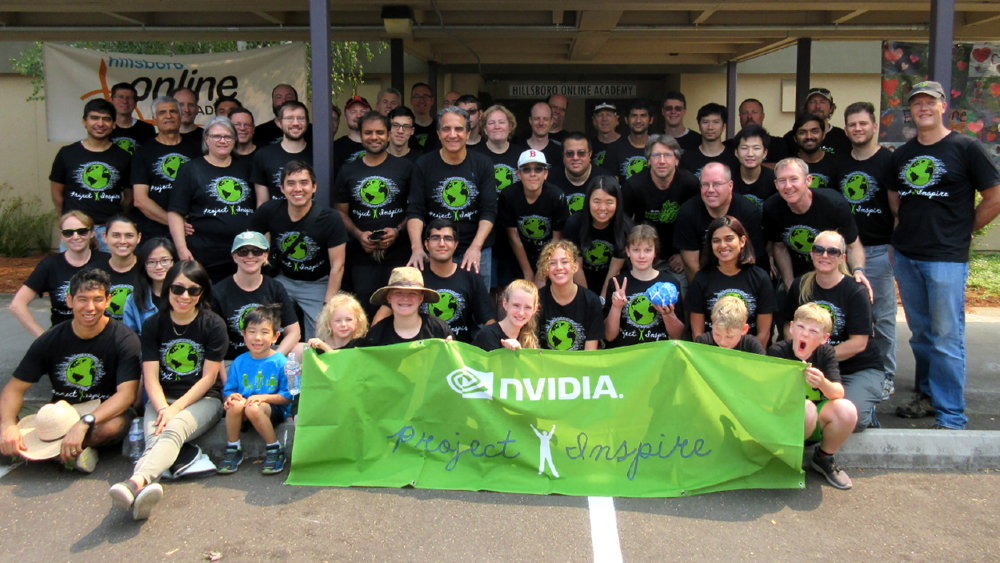
Nvidia ensures that they walk the talk on their core values, and are often praised for their authenticity with the value of ‘one team’ – removing hierarchy and politics within the company so employees can focus on solving work challenges better.
One of their commitments to their people include fostering a culture where everyone is able to focus on their work, by anticipating what each employee may need at each stage of life. Imagine this: They provide benefits that allow their employees to deal with student debt, care for aging parents, or build a family.

The internationally-renowned beauty company aims to build an inclusive work environment for everyone because everyone is beautiful! They uphold the values and legacy of their founder, such as nurturing world-class talent, encouraging a diverse workplace, and putting the community first.
As the world progresses, so does the company with its Inclusive Leadership Behaviours tool, staying true to hiring without biases and in the workplace. Unconscious bias training is also regularly conducted, making The Estée Lauder Companies an inclusive workplace that condones discrimination and provides equal opportunities for people of all races and genders.

If there's just one word to describe Netflix’s company culture? Freedom. One way the digital streaming company drives empowerment and autonomy in its employees is by giving them the power to make decisions for the company.
By doing so, employees have a greater sense of responsibility, self-discipline, and accountability that motivates them to work better. There are also ‘unusual’ instances of freedom within Netflix, like the internal and systematic sharing of documents, vacation and parental leave policy, and even an 'other expenses' policy ruled by the philosophy, “Act in Netflix’s best interest”.

‘Ugly babies’ are what Pixar President Ed Catmull calls an idea still in its infancy. At Pixar, psychological safety is adopted to protect an idea’s originality before turning it into works of art. It forms a space for employees to provide feedback and improve, as they are the ones who will judge the work and not their peers.
Moreover, the company's North Star is an inclusive work environment to produce representational content for their audience, provide opportunities for talent, and value the contribution of different backgrounds. This is most evident in recent Pixar projects like Coco, Bao, and Soul, which highlight various ethnicities and cultures in America.
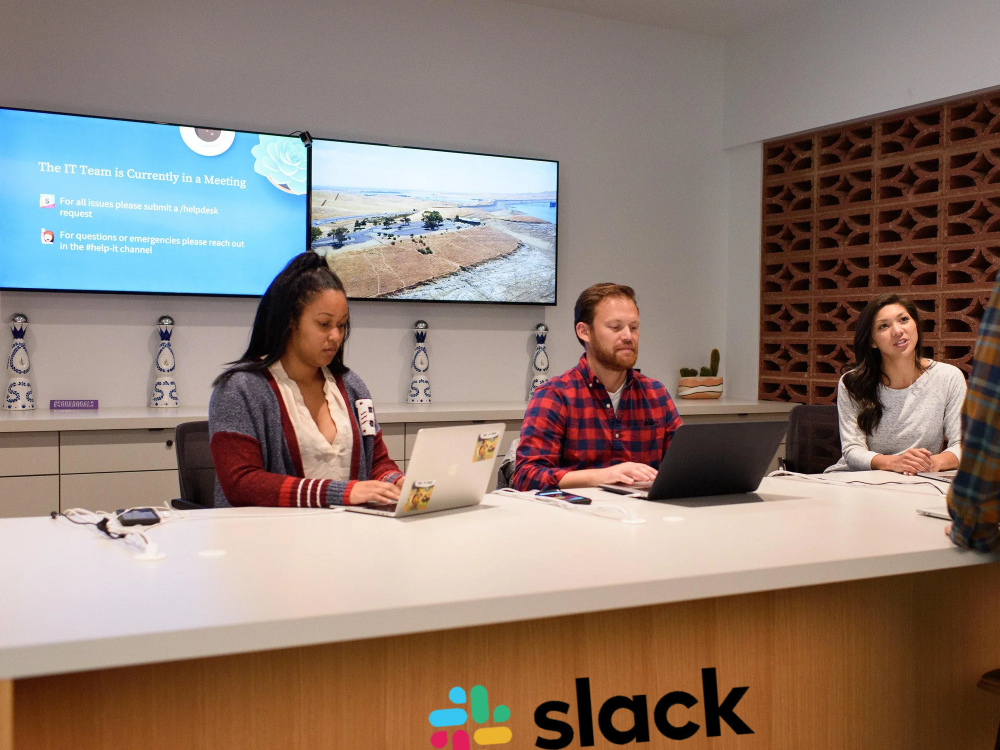
“Work Hard and Go Home” is their motto. An SaaS company that deals with technology 24/7, Slack understands that employees, too, have a life outside work. Hence, a people-first culture where employees are not expected to work after hours encourages them to speak with purpose and live their life to their fullest.
Besides that, the Slack for Good initiative provides opportunities for underrepresented individuals in technology. To date, they have built a program to help the formerly incarcerated find employment in tech; introduced community involvement, active volunteerism such as paid Volunteer Time Off (VTO), and employee philantrophy.

8 core values guide employees in everything they do, providing opportunities for them to grow as a person and member of the organisation. Their values in action form the very existence of their company culture, appreciating employees who share knowledge, care for people and the environment, lead by example, and practice togetherness.
Employees also have the space to make mistakes, as IKEA believes that doing so is better than proving that they are not wrong. This coincides with their family-focused environment, where people can be themselves and no one tries to stand out. In the words of this Swedish brand, “Only when you are sleeping, you are not making mistakes.”

“Create an environment that you want to work in” is what Shopify says, and so they did. From nap tents to townhalls where executives are front and centre in the hot seat, the tech giant fosters the relationship between the company and employees by implementing open communication and a sense of security.
Shopify also practises something called a ‘trust battery’. On an employee’s first day, their battery level starts at 50%, which can charge or discharge overtime while working with others. This concept allows for more transparent conversations regarding trust in workplace relationships, akin to performance reviews without taking criticism personally.

The driving force of Salesforce is the Hawaiian spirit of Ohana, or family, since its inception in 1999. Together with this is their unique 1-1-1 philanthropy model, Pledge 1%, that gives back to local communities.
How this integrated approach works is companies who take part pledge either 1% of equity, 1% of their time, 1% of their product, or 1% of their profit. At the time of writing, Salesforce has contributed over USD$240 million in grants, 3.5 million hours of community service, and product donations to over 39,000 non-profit organisations.

It's not about how the job gets done but more about what gets done – that’s the work culture at LEGO. Instead of being told what to do, their approach of providing employees with clarity and strategic choices allows staff members the freedom to execute their tasks the way they want them.
Fostering creativity at work also empowers employees to come up with innovative ideas to solve problems, which goes hand-in-hand with their playful, youthful brand outlook. There are no culture decks or handbooks too; just a free-thinking, non-controlling, and non-restrictive environment.

In 2021, the music-streaming company formally introduced the work from anywhere model and a flat management structure to foster teamwork and open communication, making the company a hot favourite career choice.
Its adaptive company culture doesn’t stop there. To encourage employee autonomy and accountability, Spotify adopts self-organising teams of ‘squads’, ‘tribes’, ‘chapters’, and ‘guilds’ to execute tasks or projects instead of bureaucratic top-down management styles.
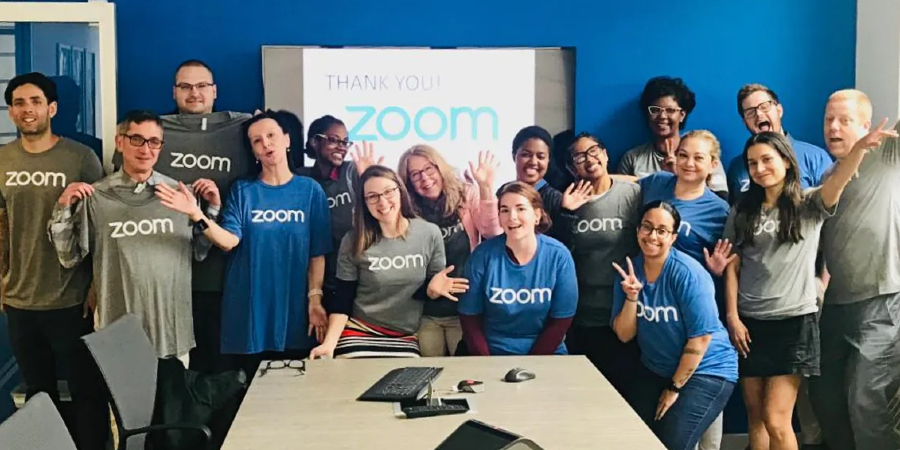
An SaaS company that thrived during the COVID-19 pandemic, Zoom wants to do more than just the same ol’ employee engagement and company culture practices. Their solution? A happiness crew to organise events, celebrations, community events, and volunteer activities.
Responsible for forming a positive work culture within the organisation, the happiness crew’s ultimate mission is that employees work in a happy environment. From this, the company has the chance to establish and implement new work cultures – to grow, adapt, and provide greater environments for employees to work in.

More than just coffee and the seasonal pumpkin spiced latte, Starbucks is driven by performance, humanity, inclusion, and relationships. The company strives to provide opportunities for refugees, veterans, military spouses, and the disabled – Signing Stores run by the deaf and hard of hearing community, as an example.
The relationship-driven approach is evident in their operations. For customers, it’s why they want to know your name, while for employees, even part-time staff in the United States qualify for health insurance and stock options. At Starbucks, you’re more than just an employee. You’re a partner.

When it comes to positive company culture examples, we can’t ever leave out Google. Known for having one of the best company cultures in the world, its love for its employees is evident, from on-site laundry centres to providing childcare at its headquarters.
They take good care of employee well-being to ensure that there’s nothing to worry about at home, so they can focus on working for the company. As their employees are their most important assets, a hybrid working model and four work-from-anywhere weeks per year truly capture the essence of an employee-first culture.
In this new age of employment, companies can no longer ignore the importance of company culture. As more talent cast their nets for the best workplace cultures to work in, business owners too must explore and develop their existing environments, as no one is more integral to a company’s success than their people.
A strong company culture not only reduces hiring costs, but also provides enhanced employee productivity, engagement, and consumer image. Plus, headhunting and aggressive hiring can take a step back, as the right talent will show up at your doorstep without being asked!

After a couple of years spent indoors due to Covid-19, countries around the world eventually lifted restrictions and resumed what became known as the "new normal". There’s been a lot of change in the workforce since then as employees moved to established companies for better job security, lobbied for flexible/hybrid working arrangements, or straight out called it quits with toxic workplaces!
The transformation was imminent and bound to happen. Remote working has been practised since the 2010s, but was only popularised recently as a very viable option because of the pandemic. With this new workplace and career demand, employers and businesses have to adapt and adopt them quickly to survive.
That means modern recruiters are facing the brunt of managing stakeholder expectations as well as the candidates' demands. For example, if the pandemic has taught us anything, it’s how to spot a company’s red flags instantly, making it challenging for its recruiters to hire new staff. Existing ones may even leave for greener pastures.
Moreover, it’s not just the recruiters and hiring managers who are interviewing candidates, but it's now the other way round too. Just as much as interviewers want to know if a person fits the vacancy, the candidates will also want to know if the role and company are right for them.
Accomplished talent are out there, and willing to take up new opportunities. The catch? Better remuneration, good work-life balance, decision-making authority, etc. Beanbags, pool tables, and an infinite snack supply are no longer highly-coveted workplace perks. Intangible benefits are the new focus, so are companies willing to invest in these, and their people?
Top talent are the top for a reason. Be it their speed of learning, ability to close sales instantly, insane understanding of complex jargon, or years of experience, they are the crème de la crème who can boost the performance of any business.

A McKinsey study in 2012 found that the relationship between the quality of talent and a business’ performance was almost perpendicular: By replacing average talent with greater talent, work productivity could increase, thus shortening timelines for projects and reaching capable business goals.
Instead of just filling a space in your workplace, the candidate you hire should be a person who can support your business and propel it further. Managers and the brains behind the team should be top talent, but it doesn’t dismiss the fact that other team players who should have just as superior skills to create a cohesive, well-oiled workflow.
The best talent are an asset, and to retain them, companies need to be willing to offer more than just a generous salary. Here are some of the things modern employees look for in a job, besides wages:
How do you find good employees for your company? It all begins with a game plan!
As the head honcho of hiring in a company, recruiters face the heavy responsibility of evaluating the best candidates to employ. But to find and retain good employees requires a well-planned recruitment strategy – almost like a football manager scouting for talent, reeling them in, and then sealing the deal with a contract.
Besides attracting top talent, a good recruitment strategy can help reduce the cost per hire by prioritising quality over quantity, increasing diversity in the workplace, and filling big shoes by targeting specifically-qualified candidates.
Some of the best ways to find employees are to post on job platforms, attend career events, enlist the help of an external recruitment or headhunting agency, and even implementing an employee referral programme. Ultimately, the goal is to attract the best employees to want to work with you.

Everyone’s on social media nowadays! You, your colleagues, your parents, your bosses – heck, even your grandparents and your pets might have accounts. Leveraging social media platforms to grow your brand creates better visibility and credibility, especially when jobseekers look up your business online.
Not only does staying updated on social media validate your online presence and business, but it can be a great recruitment tool for talent. According to Glassdoor, 79% of job seekers turned to social media to search for jobs, and a 2013 survey by SHRM (Society for Human Resource Management) found that at least 84% of organisations recruited employees through here.

Employees want more than just money. Yes, money makes the world go round, but the true value lies in a work-life balance, autonomy, career growth, personal development skills, prospective promotions, an open-minded management style, etc. A positive workplace is a productive one, with many prioritising their well-being over material perks.
By creating a positive workplace culture, everyday work can be impacted positively, and encourages employees to stay engaged. One example is flexible working conditions where employees can work remotely or in the office. Only 58% of office workers believed their culture was positive, in comparison to roughly 70% of remote or hybrid workers.

Growth is not just a part of a business, but everyone, including employees and managers. Developing these programmes in your company provides learning opportunities and transformative career growth – all while attracting new talent and retaining current ones.
Besides professional development, companies can provide training classes for employees to fill the gaps in their skills or to learn something new. The best programmes should offer formal and informal opportunities that match their needs. In reality, 76% of millennials felt that these opportunities were a major contribution to job satisfaction.

From that first interview invite to signing the job offer, the hiring process reflects the company’s operations strongly. A positive interview experience assures talent that your company is well-structured, engaged, and meets their expectations – an opinion heavily supported by 87% of candidates.
Through interviews and meeting candidates in person, hiring managers or recruiters can take this opportunity to develop stronger interpersonal relationships. Sometimes, this could be the deciding factor on whether a talent decides to accept a role or not, tying back to the importance of the overall experience.

Passive candidates refer to candidates who are not actively looking for a new job. In fact, they could be very comfortable right where they are. Research says that at least 70% of the world’s talent are passive, biding their time until greater opportunities pop up.
To target them specifically and bring them onboard, you’ll need plenty of research and find out what their goals are. This helps create a tailored approach as one of the best ways to find employees, and gives recruiters a wider net of experienced candidates to select from.

Birds of a feather flock together, and it can go the same way for talent! If you already have talented employees on your team, an employee referral programme is the most effective tactic to bring onboard top quality fresh blood.
When an employee refers someone for a job, they wouldn’t refer an unskilled candidate. They would recommend someone who’s just as good as them, if not better. An ERIN report in 2020 discovered that employee referrals lead to a higher hiring rate (at least 4x), and 45% of referred employees remained in the company for over four years.

A few ways to do this are partnering with schools to seek young talent or hosting/joining a career fair. It puts your business directly on the ground to meet candidates in real life, and to be easily identify if they’re a good fit for the company.
Plus, having existing employees present themselves as brand ambassadors can help prospects feel more comfortable speaking to someone already working there. Almost like talking to a friend, as at times, recruiters and managers can come across as imposing.

Like children asking “Why this?” and “Why that?” to everything, employees want a ‘what/why’ in their job too. Why are they doing this, what is the company’s purpose, and how can they make it happen?
Employees feel more empowered when they work towards meaningful goals. PWC’s 2016 study showed that millennials were 5.3x more likely to stay on in a company when they resonated strongly with their company’s purpose. Hence, employers must ensure their companies are purpose-driven and embody strong values to appeal to and maintain talent.

To attract the best talent to join your company, utilise creative aspects in your job ad postings to get attention, like videos and graphics. Nobody wants to read long text paragraphs about the company and vacant roles. Make it short, snappy, interactive, and honest.
“But I have so many things to put into my job post!” And in the age of social media, attention is fleeting as we jump from post to post, and platform to platform in mere seconds. Shorter job ads (1-300 words) had higher application rates compared to medium (301-600 words) and long job ads (over 601 words), making concise information key to attracting eyeballs.

The world is moving faster than before, and for businesses to stay in the race, they need to be flexible and integrate the latest career and industry trends. Be it remote working, introducing new technology to ease efficiency, or jumping on the live-streaming wagon, these practices help companies stay up-to-date as well as appeal to candidates as a proactive and progressive place to work at.
Companies often emphasise that their success stems from their people, and that couldn't be more true! If there were no humans to man the machines, calibrate systems, look things over with a sharp eye, or provide an empathetic touch to everyday life, businesses would feel robotic and devoid of life.
More than just manpower, they are the company’s biggest stakeholders. They act as unofficial brand ambassadors and can affect your public brand image. If employees are happy and view their companies positively, they would be more than willing to share their experiences with others as they feel valued. For a business to come to fruition, it starts with nothing else but people.

We previously took a look at the industries and new technologies that will thrive post-pandemic, as well as the current opportunities and outlooks that are driving demand for talent. It's clear that most regions and industries are still remaining strong, with many parties cooperating to ensure that job opportunities will still be available. So, where are the likely key areas where the labour market might improve?
Here's a list based on the estimates and projections of labour force in the World Employment and Social Outlook Trends 2022 report, by the International Labour Organisation:

One thing to keep in mind is that technology is among the key factors influencing the growing labour force. As noted by the World Trade Organisation in their presentation "Impact Of Technology On Labour Market Outcomes", current technological advancement has resulted in a higher relative demand for skilled workers and a lower relative demand for workers performing routine tasks.
However, don't forget that the tech and digital industries were among the hardest hit by the pandemic.
Like some other industries, the tech and digital industries experienced some eye-opening surprises as a result of the Covid-19 pandemic, but some detrimental repercussions could not be avoided. Before we recall the devastation that had befallen the tech and digital industries, let's first look at the positive effects that would last for a very long time.
Many of us have grown accustomed to our working environment as more people receive the Covid-19 vaccine, borders have opened on a national and international level, and certain things have returned to their pre-pandemic state. However, because new coronavirus variants will continue to plague us, the fight against the pandemic is far from over.

The current state of the working world is also unstable because, as noted by the Harvard Business Review (HBR), this year's level of volatility will rise as new variants continue to emerge, and many employees will experience real wage cuts as annual compensation increases lag inflation. These are all present, along with longer-term technological change, ongoing DE&I endeavours, and ongoing political upheaval and uncertainty.
The following five fundamental trends will affect workplace volatility in 2022:
Gartner HR Research reveals that 82% of employees report working environment lacks fairness. Unfairness will continue to be a hot button issue for many businesses as flexible, remote, and hybrid work models become more prevalent. There will be disputes among employees and inquiries from their superiors over who gets to work from home more frequently, who is more productive at work, and other related issues.
Many, if not most, employees in today's workplace seek flexibility. Given that flexible scheduling is associated with lower employee turnover in organisations, it is safe to assume that the opposite will result in high turnover. Employers who don't offer flexibility run the risk of losing employees to employers who do, increasing attrition risk as well.
Remote work is a great solution that has become popular for staying safe during the pandemic, but it presents employers with the conundrum of how to measure remote employee productivity. Their decision may cause friction between those who work from home and those who work in the office because, according to a Gartner November 2020 survey of nearly 3,000 managers, 64% believe that on-site employees perform better, and 75% believe that on-site employees are more likely to be promoted.
According to HBR, more than 90% of employees intend to use a hybrid working model for their knowledge workers in 2022. However, nearly halfway through the year, some companies have stated that they want their employees back in the office. As many as 58% of companies polled by Teamlease believe that work will be done entirely in-office in the future. Employees and management may clash as they adjust to the new working model.
In 2022, organisations will implement new measures to assess their employees' mental, physical, and financial health, as mentioned by HBR. Following the pandemic, many businesses increased their wellness support. For example, a Gartner 2020 survey of 52 HR executives discovered:
Thus, employers must understand whether employees are taking advantage of the benefits and whether any of the benefits have assisted them in improving their well-being.
When coping with the new working environment that follows the pandemic, various viewpoints and approaches are available out there. Fortunately, a number of corporate leaders are voicing their views on the subject and wanting to assist employees in dealing with the new challenges. Check out some of their responses below:

“CIOs and IT leaders are trying to wrestle with, you know, 'What's the level of flexibility I give my workforce here? Can I let them have an Apple Watch Connect?' Well, you probably should, because this generation considers that part of their productivity stack – a part of how they stay connected.”
He continued, “So you take all those conditions, and the data is clear. IT leaders are now going to have to manage this extreme flexibility and how they allow their workforce to connect and do their jobs. In fact, what I find compelling about the data is that it suggests they'll sacrifice promotions and pay and positioning for flexibility.”

"For many companies, data will be part of day-to-day work and overarching strategy, if it isn’t already. This is especially true at Healr Solutions, which uses data to create solutions for biopharmaceutical supply chains. As we progress to the future, work will be heavily dependent on making decisions based on large datasets."
He continued, "At Target, we use data-driven tools to support quicker, more effective decision making. The way of the future is using that information to improve speed and quality of service to meet guest expectations."

“Bots offer a particular opportunity for highly regulated industries like health care that have codified activities. A bot can bring a quick solution, reducing the risk of human error and freeing up time for researchers.” She continued, “Amgen is thinking about existing skills and determining where gaps are, with an emphasis on involving employees in solutions.
She continued, “This includes explaining why changes are made and how more and new technology will benefit employees by helping them develop new skills and free up time. People are worried they’ll be replaced by technology and lose their jobs. This can be quickly addressed once individuals understand how these tools will help them perform better and more efficiently.”

“If you want to predict the future, you don’t look at big companies or older companies – you look at young companies, especially for [work] culture. Airbnb’s 'work from anywhere' model isn’t just forward-thinking, but unique in its approach to salaries, as almost everyone with flexible work policies still ties employees’ pay to their locations.”
He added, “The most talented people aren’t in San Francisco anymore, and they’re not here in New York. The most talented people are everywhere now – and if I need engineers, designers, product managers, or marketers, they’re getting so distributed that if you limit your talent pool to community radius, you’re probably at a disadvantage.”
Due to the pandemic, organisations from all sectors have changed how they operate, who they hire, what kinds of jobs they offer, and other aspects of their business. In just two years, many aspects of how people work have changed drastically. To avoid falling behind and maintain their competitiveness in the labour market, both employers and employees must quickly adapt.
Just as the World Economic Forum and Boston Consulting Group reported on some potential outlooks for the workplace of the future. These include elements like the rapidly expanding global workforce, extensive automation of employee tasks, a higher percentage of the workforce moving to remote positions and entrepreneurial endeavours, and a higher proportion of high-skill areas moving into high-skilled jobs.
What can employers do to help employees get ready? Making a workforce that is prepared for the future is the key. The BCG recommended the following actions for businesses to take, in order to meet the challenges of upskilling and future-proof their workforce while also ensuring employees are prepared to face any work challenges that come, especially in the future of work:

The pandemic has changed how people work, live, receive healthcare, and shop and these changes will boost demand for tech and digital occupations. Many people will be curious as to whether the situation will change back to how it was before the pandemic. But each of us needs to keep moving forward and take the necessary actions to adapt to what is happening right now and in the future in this quickly changing, constantly evolving world.
The ongoing pandemic and economic uncertainty make the future unpredictable. In some industries, there may be more open positions, while in others, there may be more layoffs. Employees may reduce working hours or work from home full-time, but it is also possible to do the opposite. There are a lot of potential changes, but here are some predicted by Gartner for the workplace over the next ten years:
If you're looking for more about the future of a post-pandemic world, why not check out our other article coverages:
1) Pandemic-Rebound Part 1: Which Industries/New Technologies Will Thrive And See A Rise In Hiring?
2) Pandemic-Rebound Part 2: What Are The General Outlooks And Opportunities From Around The World?

There's no doubt that the Covid-19 pandemic has wrecked havoc of unbelievable proportions: Economic and geopolitical systems weakened, high commodity prices, inflation, as well as disruptions to the international trade and supply chains. Despite all of that, countries have done their best to overcome the hard-hitting impacts to their economies, in addition to proving how resilient they are in different settings. However, even with plenty of recovery practices in action, many experts fear that a global economic recession is on the horizon.
Apart from that, the world of work has changed dramatically across all industries, and nearly all have invested in a digital way of doing business. Thanks to each country's efforts to get back on their feet, job opportunities still abound in various parts of the world, especially for those who possess the necessary knowledge and skills, as well as the courage and mindset to explore and rule new dimensions.
This is consistent with the findings of the Project Management Institute's (PMI) 2021 Talent Gap report, which estimates that by 2030, the world will require 2.3 million additional project management professionals annually to keep up with demand. Adapted from the PMI 2022 Jobs Report, let's take a look at the current opportunities and outlooks that are driving demand for project leaders by region:
| Region | The Outlook | The Opportunity |
| Asia Pacific | This part of the world is a manufacturing powerhouse that has fueled economic growth by capitalising on international demand for its goods. Exports have been increasing in the region until pandemic-related setbacks. For instance, Japan’s growth rate decreased by an estimated 0.8% when the country’s Covid-19 cases increased in late 2021, leading to lockdowns. Additionally, the IMF significantly cut its growth projection for the Asia-Pacific region in October compared to earlier projections, citing the region's uneven policy support and slow vaccination coverage. Nevertheless, all indicators point to growth in the coming year. In contrast to South Korea's projected growth of 2.7%, Australia's economy is projected to expand by 3.5%, New Zealand's by 3%, and Japan's by 2.3% in 2022. | Although exports may be the main driver of economic growth in the region, hiring is not the only encouraging trend. According to market research company Mordor Intelligence, fintech is booming in the area and is predicted to grow by 16% annually through 2026. Throughout the pandemic, Australia had remarkably low rates of job switching, but this is now changing as the inflow of project talent from abroad has decreased due to border closures brought on by Covid-19. Despite the worst hiring outlooks for Q1 2022, employers in all 40 countries surveyed expressed optimism. Construction, healthcare, government, and social work all face potential contractions, but banking, finance, IT, and telecom show encouraging hiring sentiments. |
| China | The IMF predicts that the second-largest economy in the world will see GDP growth slow from 8% in 2021 to 5.6% in 2022. According to the Oxford Institute for Energy Studies, the nation is experiencing an energy crisis due to record-high coal and natural gas prices, which may hinder the government's ambitious plans to transition to renewable energy sources. Also, one of the biggest worries is China's highly indebted real estate market. Meanwhile, the Chinese government unveiled a five-year plan to increase employment and wage growth in light of the nation's anticipated record 9.1 million new workers in 2017. By 2025, 55 million new urban jobs must be created to keep the official urban unemployment rate at 5.5%. There are signs that project activity will pick up in the interim. | China's finance ministry committed CNY1.55 billion to wind farms, CNY2.28 billion to solar power plants, and CNY38.24 million to biomass power generators, in November. The need for project leaders is then anticipated to increase due to China's energy transition plan and the requirement to prepare for climate change risks. Private businesses also want to intensify their sustainability efforts. According to Karl Fjellstrom, managing director of Far East Mobility in Guangzhou, local eco-friendly transportation initiatives will spur demand for project talent. In addition, the pandemic is boosting opportunities in the pharmaceutical industry, particularly for biologic medicines, and there’s a sizable market for project management and technical personnel. |
| Europe | The European Union's economy is strengthening, with 2021's end-of-year GDP growth expected to be 5.2%. The OECD anticipates that the GDP of the eurozone will increase by 4.3% this year and that unemployment rates will return to pre-epidemic levels, barring unanticipated issues from other Covid-19 variants. But supply chain problems, particularly in the transportation and construction industries, have exacerbated bottlenecks and slowed manufacturing efforts. Growth and job gains will be restricted until pricing and supply chain disruptions are stabilised due to the ensuing spike in inflation, which will be 5% in December 2021. Several nations are taking actions to encourage project funding and spur job growth over time to lessen the effects of disruptions in Europe's energy supplies and unrelated spikes in natural gas and electricity prices. For instance, the United Kingdom enacted a two-year "super deduction" tax break, while France’s 2030 plan will invest €30 billion over the following five years in a variety of commercial sectors. | A record-breaking US$121 billion was invested in European technology in 2021, more than tripling the amount invested the year before. The rapid rate of pandemic-driven digitisation, combined with this investment and the IT industry's attempt to fill a talent gap, have created the ideal IT opportunities for project professionals. In many industries, like transportation and construction, where project leaders are required to promote innovation while minimising risk, there’s a shortage of labour. This shortage, coupled with supply-chain disruptions, has led to an increase in demand for project professionals in these sectors. The need for project managers for renewable energy sources is being fueled by the rising price of fossil fuels and the increasingly ominous climate predictions. As part of his France 2030 plan, President Macron has also set aside €8 billion for energy initiatives, intending to lower greenhouse gas emissions and becoming a global leader in green hydrogen. |
| Latin America | Despite having a GDP growth rate of 6.3% in 2021, this region is only anticipated to grow by 3% this year. This is due to a widespread and historic drought crippling the hydroelectric generation in Latin America, which once provided the majority of Brazil's electricity. Governments are now relying on imported natural resources as energy prices globally soar. The presidential elections scheduled this year in Chile, Colombia, Costa Rica, and Brazil, also have a history of disrupting the economy. There are some encouraging signs amidst the fear and uncertainty, even though employment levels in many Latin American countries are still significantly below their pre-epidemic levels and inflation is rising fast. Critical projects in Latin America will be financed by the Build Back Better World global investment initiative, which the G7 group of major industrialised economies launched in June. | According to Elton Soares, PMP, lead project manager, GE, Santa Cantarina, Brazil, companies are constantly trying to adapt, so project professionals who are knowledgeable about the latest developments are needed. And anyone who can assist businesses in navigating the pandemic and the emergence of AI is in a good position to advance their careers. While there are opportunities in all industries, the manufacturing and technology sectors have the most open positions for project managers. There are more IT job openings than qualified candidates, based on the study published in late 2021 by Brazil's Softex. In 2022, 400,000 IT positions, according to Softex, are expected to be vacant. Opportunities in technology aren't just limited to conventional IT. To remain relevant for digital consumers, healthcare, retail, education, and financial services are becoming more and more entwined with technology. To stand out to hiring managers, job candidates should highlight any agile experience and professional certifications. |
| Middle East & North Africa | In 2022, the Middle East and North Africa should see a reduction in the economic damage caused by the pandemic and falling oil prices, opening the door for another round of the region's famed high-profile megaprojects. Given the rapid Covid-19 vaccination campaigns and government spending initiatives related to the pandemic, the IMF increased its economic growth projection for the region to 4.1%. Late in 2021, oil production grew significantly, and prices climbed to their highest level since 2014. The World Travel & Tourism Council reports that tourism is also on the rise, with growth expected to reach about 27% in 2021. Even though those figures are below the average for the world, Expo 2020 Dubai may help increase them, as the emirate reported receiving more than 1 million foreign visitors in just a month of October. The hospitality industries in Qatar and Bahrain were severely impacted by the pandemic as well, but they report encouraging increases in tourist spending and travel in late 2021, largely due to Qatar hosting the FIFA World Cup in 2022. | All indications are that project activity and job opportunities will pick up as core industries recover. For instance, it's anticipated that construction spending will surpass US$110 billion for the second year in a row in the six-nation Gulf Cooperation Council. Moreover, Saudi Arabia and the United Arab Emirates (UAE) are predicted to be at the forefront of the field thanks to their diverse portfolios of residential, mixed-use, commercial, and touristic buildings, as well as their energy and infrastructure projects. Long associated with fossil fuel energy, the Middle East and North Africa are now home to several renewable energy projects, such as the Al Dhafra Solar Photovoltaic Plant in the United Arab Emirates. And BP recently announced plans to build multiple gigawatts of renewable energy and green hydrogen projects in Oman by 2030. Project managers must still adjust to pandemic-driven changes that redefine "business as usual" even as the economy begins to recover. Additionally, there’s a demand for project talent in developing research areas like software engineering. These research teams will require more members who can create procedures and frameworks. |
| North America | Despite of supply-chain bottlenecks, a talent shortage, and worries about Covid-19 variants, growth in the United States and Canada is anticipated to continue. This year, the IMF predicts that the GDP of the United States will rise by 5.2% and that of Canada by 4.9%, both of which are 0.8 percentage points less than in 2021. The ability of government officials to control inflation will also determine how quickly and effectively the economy can grow. Even though the Great Resignation movement may be currently centred in the United States, the unemployment rate fell to 3.9% in November, the lowest level since Covid-19 first appeared. Three million American workers left their jobs during the pandemic, and many businesses are having trouble getting them back. Many businesses are increasing salaries to combat rising inflation and a lack of qualified workers. The Conference Board conducted a survey, and the results show that businesses are budgeting an average of 3.9% of payroll for wage increases in 2019—the highest level since 2008. | Because there are so many opportunities in the United States, job seekers can generally indulge in the luxury of being picky. The sectors expected to hire massively are manufacturing, professional and business services, transportation, and construction. The healthcare industry is also flourishing. The auto industry and other segments of the manufacturing sector in Canada have been slowed by supply-chain disruptions. As a result, there will also be a high demand across all industries for project managers who can proactively identify, manage, and reduce the risks associated with supply-chain bottlenecks. The need for changemakers who can lead these transformations will grow as organisations move further toward automation and digitisation as a result of hiring and logistical issues. In the first half of 2021, the declining foreign investment made it difficult for Canada's mining, agriculture, manufacturing, and energy sectors to thrive. The Conference Board of Canada, however, predicts that as exports rebound in 2022, there may be a corresponding rise in demand for talent in those industries. |
| South Asia | The demand for goods has only grown over the last two years, and India's significant contribution to the electronics supply chain is anticipated to contribute to the nation's 8.3% growth this year. However, the disparities in South Asia's economies continue to be enormous. Each nation's economy has been influenced by different levels of tourism dependence, extreme weather events, and Covid-19 containment strategies. The pandemic's uneven effects have been felt not only along geographic lines but also along gender lines. According to a 2021 study from Azim Premji University, among Indians who lost their jobs during the early-2020 lockdown, nearly half of women had trouble finding new employment, compared to just 7% of men. Inequities for women and unskilled workers have only grown worse as a result of the pandemic. The World Bank's most recent statistics show that from late 2020, just 16.1% of workers were women, down from a peak of 26% in 2005. | It's not surprising that the IT industry in India continues to offer many job opportunities, especially in light of the significant push for digitisation across industries. Many new IT projects have become available as a result of the rapid pace of digitisation in both internal and customer-facing operations. In the meantime, a survey by Willis Towers Watson predicts that salaries in India will increase by almost 9% in 2022. Companies are more willing to spend more on project managers who have an entrepreneurial mindset, can affect culture change, and can form enduring, effective teams. Another booming industry is telecom. The Naukri JobSpeak Report indicates that between November 2020 and November 2021, hiring activity in the industry increased by 91%. Additionally, professionals with eight to twelve years of experience were in high demand across all industries. Another promising sector is telecom. The hiring activity in the industry increased by 91% between November 2020 and November 2021, according to the Naukri JobSpeak Report. The most in-demand professionals across all industries were those with 8-12 years of experience. |
| Sub-Saharan Africa | The GDP growth predicted for this region's economy in 2022 is expected to be 3.8%, or almost equal to the gains from the previous year. However, that regional rate obscures the fact that different nations are experiencing unequal growth. For instance, growth in Ghana and Kenya is anticipated to be at least 6%, compared to much more modest growth forecasts for Nigeria (2.7%) and South Africa (2.2%). The two main factors influencing global trade and commodity price increases are growth in general. However, low Covid-19 vaccination rates keep limiting project potential. The World Health Organisation reports that only 6% of the population in Africa had received Covid-19 shots as of late 2021, making it the region with the slowest vaccination rollout worldwide. | Sub-Saharan Africa is looking toward much-needed infrastructure upgrades, many of which are supported by government assistance, despite challenges brought on by pandemics. Various projects, such as upgrades to water supply systems, government-subsidised housing, and student housing, have been launched in South Africa with the assistance of a US$7 billion fund of private and public investments. Around US$32 billion of global aid are spent in Africa, which is fueling the creation of new development jobs there, up to 45% of which will require project talent. Project management hiring will increase as a result of the growing demand in development organisations to show accountability and results. The need for project managers who can support teams in delivering proactive and sustainable solutions is also being driven by climate change. |
If you're looking for more about the future of a post-pandemic world, why not check out our other article coverages:
1) Pandemic-Rebound Part 1: Which Industries/New Technologies Will Thrive And See A Rise In Hiring?
2) Pandemic-Rebound Part 3: What Are The Long-Term Impacts And Newest Trends We Can Expect?

What legacy will Covid-19 leave in a world that has changed drastically, but is more resilient? The effects of the pandemic, which resulted in many lives lost and countless people losing their jobs due to its rapid and unchecked spread, are still very much felt to this day.
While employment began to recover months later, it remained high throughout 2020. Nevertheless, many industries continue to view the pandemic as a blessing in disguise. Companies took all the necessary measures to ensure business continuity and survival, as the entire world worked to contain the pandemic. It has fundamentally altered how people interact with one another, and has sparked unheard-of changes in every sector of the global economy.
The pandemic ushered in a period of opportunity for new industries to develop and shape consumer behaviour for decades to come, much like previous recessions.
While some already-existing industries will likely struggle to survive, some will flourish as they are compelled to transform, reorganise, and evolve to fit the new norms. Just consider how many things, including workouts and school classes, became available online in the aftermath of the outbreak.
According to a CBINSIGHTS Research Report, the following are some of the industries and technologies poised to thrive and shape the post-Covid world.

Due to overcrowded hospitals and the risk of infection, patients and healthcare professionals were forced to quickly adopt telehealth services and remote health monitoring. McKinsey reported that from July 2021, telehealth services were used 38 times more frequently than they were before the pandemic. VC firms jumped on this trend quickly, and invested three times as much money in digital health startups in 2020 compared to 2017.
Telehealth technology, continuous and remote diagnostics, remote mental healthcare, virtual fitness, plus aging-in-place technologies may all continue to develop as infrastructure advances and these services become more widely known. This could be true even after the pandemic has ended.
People have been confined to their homes as a result of social isolation policies, making remote work and workplace flexibility trends necessary. Many businesses were forced to make the switch from traditional office work to remote work. Employers and employees thus utilised technology, such as virtual reality and video conferencing apps like Zoom and Microsoft Teams, to balance productivity with overall well-being.
Due to the explosive growth in demand for its services in 2020, Zoom's share price increased by almost 400%. As a result, tech firms have seen unprecedented network stress, and a massive demand for their services. The new workplace norm is thought to be here to stay, even after the pandemic has passed, because businesses across all industries had to adjust to the difficulties of a suddenly dispersed workforce.

The Covid-19 outbreak had an impact on the $96.6 billion fitness sector. Over 350,000 fitness instructors and trainers in the United States alone were forced to switch to virtual classes. Many of them have adapted by using already-available video-streaming services like Zoom, Instagram Live, FaceTime, and YouTube that weren't necessarily designed for the purpose. According to ClubIntel, 72% of fitness club owners now offer on-demand or live-streamed workouts, up from just 25% in 2019.
Even though many gym-goers are content with their new home gyms, physical fitness may experience a rebound as the Covid-19 crisis passes. One appealing feature of in-person fitness is the routine of going to the gym for spin classes or other workouts, but it's more than that. However, a hybrid model of at-home and in-person workouts is probably here to stay due to the added convenience of virtual fitness, and the lower cost of digital classes compared to those in studios.
Before the start of Covid-19, it was anticipated that the market for enterprise VR hardware and software would reach a value of $12.6 billion by 2025. For years, businesses have been figuring out how to use the technology. In the early fall of 2021, Facebook released a beta version of Horizon Workrooms, a VR remote control app. This release represented the next stage of this shift. The app allows Oculus Quest 2 VR headset users on Facebook to present themselves as avatars during virtual meetings.
The implementation of social distancing laws and the widespread adoption of remote work has given VR tech companies the chance to prove their value to businesses in unforeseen situations. Additionally, VR has supported business operations across a variety of sectors. Social distancing indicates that many in-person tasks can be carried out safely, effectively, and at scale in the virtual world, suggesting that virtual reality may one day become a constant part of enterprise infrastructure.

Long before the pandemic, analysts predicted that schools and universities would value the edtech market at $350 billion by 2025 as a result of updating their infrastructure to include digital alternatives to the traditional classroom. Covid-19's arrival, however, compelled a much faster expansion. During the height of the pandemic, remote learning technology and online courses filled the demand. However, the widespread return to in-person learning in the US was a sign that remote learning is likely to remain a backup option in most circumstances.
Even after the virus has passed, schools and universities will probably still use digital learning infrastructure as it advances, because there's plenty of room for improvements. While this is going on, tech behemoths like Microsoft and Google will keep funding their initiatives in the field of education, leveraging their existing connections with parents, teachers, and administrators who use their products.
The coronavirus pandemic has revealed how vulnerable the manufacturing and logistics sectors are to a sudden, widespread disruption in human labour. Businesses are likely to take action to protect themselves from similar disruptions in the future. To reduce the industry's reliance on human labour and aid manufacturers in adapting to shifting market conditions, this is likely to include increased investment in adaptable, scalable, automated solutions. Particularly well-positioned to speed up that evolution are automation and 3D printing.
When it comes to adapting to rapidly shifting demand, 3D printing technology has proven to be flexible and adaptable. For instance, Stratasys, the company that owns the popular 3D printer brand MakerBot, partnered with Massachusetts General Hospital to co-sponsor an innovation contest for the creation of printable ventilators. Besides converting its facilities to support the production of emergency medical supplies, UNYQ, a company that creates 3D-printed prostheses for amputees, did the same. The value of 3D printing for rapid prototyping will also drive increased adoption in sectors like manufacturing, automotive, and robotics, which together make up a $63 billion global market.
On the other hand, automation represents a long-term change in how businesses conduct themselves and is not a band-aid. According to the consensus of industry analysts at CB Insights, it represents a $337 billion global market. The organisations that take action to further automate their business processes during the crisis will probably keep doing so after it has passed, and adoption will spread beyond them as other businesses automate to keep up.

Although Covid-19 may have exposed the flaws in the just-in-time logistics strategies favoured by many supermarket retailers, it has also given businesses new opportunities to strengthen those weaknesses. Due to the pandemic, there’s now an unheard-of demand for online grocery delivery services, with many customers making their first purchase (and more!). Both regional chains and independent stores have had difficulty keeping up. In areas particularly hard hit by Covid-19, like New York City, orders that used to take hours to complete are now taking weeks.
Larger retailers like Amazon and Walmart will probably increase their market share in the future by enhancing the online grocery shopping experience with technological advancements like 3D product renderings, as well as customer service enhancements and quicker delivery times. At the same time, the pandemic has compelled businesses to invest heavily in their online operations, and the momentum that virtual commerce is gaining appears likely to last into a post-virus era.
Many customer support teams have found themselves fielding a noticeably higher number of calls from customers with inquiries about return and cancellation policies, store closures, and other topics in addition to fulfilling orders and processing sales. Businesses that use conversational artificial intelligence (AI) and cloud-based call centres may be better able to navigate the post-Covid-19 world than those that rely on face-to-face interactions; this dichotomy is likely to further divide the service economy in the years to come.
Many retailers have embraced chatbots as a component of larger social media engagement strategies because they understand the value of meeting customers where they are. For example, H&M and Sephora have introduced conversational agents on Kik, while brands like Burberry and Tommy Hilfiger have introduced their chatbots on Facebook Messenger.
As the number of online orders rises and consumers look for new ways to buy goods and services online, companies like fast food chains, governments and local authorities, as well as health organisations, may come to rely more heavily on conversational agents in the future. The quality of the information consumers can access and the simplicity of interaction will be chatbot developers' greatest competitive differentiators in the post-Covid-19 world.

Many businesses have switched from using physical offices to cloud-based solutions for their call centre operations over the past ten or so years. The pandemic largely disrupted call centres that were still located on-site. An example would be Verizon that was forced to halt operations at its call centres in Wilmington (North Carolina) and Elgin (South Carolina) in March 2020 after staff members tested positive for Covid-19.
Cloud-based call centres have grown to be a popular choice for businesses looking to keep up support operations in the face of physical distancing policies. The collaboration between Amazon Web Services (AWS) and ServiceNow to offer an AI-driven "contact center-as-a-service" product suggests that these services may become more common even after the pandemic, as more businesses seek to lower their support costs while maintaining or raising current levels of customer care.
When social segregation became mandatory everywhere, fintech had a chance to convince users that it was worthwhile to entrust an app with their money. Despite of this, regulation will have a big impact on how opportunities in the fintech sector develop in the post-Covid era.
In the wake of Covid-19, public opinion has drastically changed in favour of contactless payment methods. According to surveys, a growing number of consumers view contactless payments as a fundamental requirement for products. Businesses are already responding to consumer demand, quickly implementing contactless payment methods in grocery stores, restaurants, and other critical establishments.
Additionally, branchless banking presents a sizable enough market opportunity for fintech to start providing banking services. High-yield savings and checking with ATMs were two of the cash-management products that Robo-advisor Betterment unveiled in October 2019. Acorns, a micro-investing app, adopted a similar strategy in May 2020 and expanded its lineup of retirement and investment products to include a Spend Account. Whatever the case, it's likely that digital financial services will continue to grow after lockdowns are lifted given the convenience and security they provide.

Many customers were looking for virtual simulations of entertainment events like concerts and events, gaming leagues, and food festivals when venues closed and large gatherings were temporarily prohibited with the emergence of Covid-19. Most live events were completely cancelled, and many that offer virtual tickets in addition to in-person passes have moved to online only.
Some events have employed cutting-edge strategies to host virtual events and increase their online event programming to avoid losing additional revenue. For instance, in April 2020, organisers staged a virtual version of the Grand National horse race in the UK using computer graphics and sophisticated algorithms. Legislative meetings are also increasingly taking place virtually. The UK's lawmakers also held the first-ever "Parliament via Zoom" in the same month, which was the first time in more than 700 years that Parliament had not convened in the House of Commons.
However, since many event organisers are unable to charge the same fees for virtual events, the necessity of virtual events may have a long-term effect on event revenues. Nevertheless, AnyRoad reports that event organisers anticipate raising their spending on online experiences by 58% in the future. Future improvements for event planners include crisis management, contractual knowledge, and a new set of marketing and technology skills.
Budgets for cybersecurity are rising as more people are now required to work online. This is because the widespread use of remote work has exposed security system flaws in organisations. Separately, long-standing innovations in data privacy and surveillance technology are regaining attention.
Although cyberattacks are a constant in the online world, they have increased significantly since the Covid-19 pandemic, sometimes by more than three times month to month. Nowadays, a large portion of the world works remotely online; there’s a growing demand for online delivery and shopping services; online streaming services are the preferred method of entertainment. These points of entry give cybercriminals more opportunities to locate vulnerable targets.
Security issues surrounding these applications will probably continue as distributed work and education become more prevalent in everyday life following the Covid-19 crisis. Businesses are more likely to implement strict corporate security and compliance structures to accommodate more remote workers. The Global Cyber Security Market was estimated to be worth $140.12 billion in 2021, and it's anticipated to grow to $423.56 billion by 2028.

This technology became a crucial tool for containing the spread of the virus. Given the seriousness of the threat, there has been a shift in public opinion toward the incorporation of surveillance technology into daily life, provided that it aids in detecting and reducing the spread of the virus. It's anticipated that The Global Video Surveillance Market will grow from $40.1 billion in 2020 to $81.3 billion by 2028.
Technology behemoths have also combined efforts to track people's movements. Google's Covid-19 tracker uses information from users’ mobile phone locations to examine how movements within communities have changed as a result of the pandemic. The Exposure Notifications System for Android and iOS, which was jointly developed by Google and Apple, ensures easy contact tracing on mobile devices.
Several camera manufacturers have asserted that their infrared and thermal imaging cameras are capable of detecting fever, aiding in the post-Covid-19 world's need for the screening of sick people. Some experts predict that thermal imaging cameras will continue to be used, even after the pandemic is over, including for surveillance purposes unrelated to health.
Since funding and technological advancements have increased awareness of the market, food delivery has already experienced a surge in popularity. Last-mile food delivery has also been steadily gaining media attention. The Covid-19 crisis has only accelerated the rise of various delivery services to the point where they are now an essential aspect of customers' lives.
Between March 2020 and March 2021, delivery orders in the US increased by 142% and carryout orders by 130%. On the other hand, cloud kitchens (also referred to as dark kitchens, virtual kitchens, or ghost kitchens) are eating establishments that accept orders and deliver them without allowing customers to eat in. Demand for food delivery from these cloud kitchens has increased as a result of Covid-19's requirement that people stay at home.
If you're looking for more about the future of a post-pandemic world, why not check out our other article coverages:
1) Pandemic-Rebound Part 2: What Are The General Outlooks And Opportunities From Around The World?
2) Pandemic-Rebound Part 3: What Are The Long-Term Impacts And Newest Trends We Can Expect?